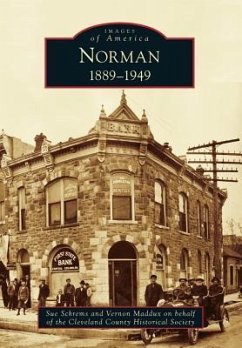On April 22, 1889, the federal government opened the unassigned lands in central Oklahoma for settlement. Entrepreneurs, cattlemen, and farmers, all seeking new opportunities, anxiously staked their claim to town lots and 160-acre homesteads. From their tents on Norman's Main Street, businessmen started to sell their wares. Tents soon gave way to wooden shacks and, finally, two-story brick buildings. By the beginning of the 20th century, Norman was a bustling frontier town that quickly matured into a trade center, a county seat, and a university town. In the 1940s, Norman became the home of the Naval Air Technical Training Center, a naval base constructed to train navy pilots and ground support crews for World War II.
Bitte wählen Sie Ihr Anliegen aus.
Rechnungen
Retourenschein anfordern
Bestellstatus
Storno

